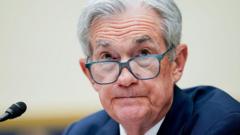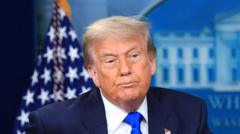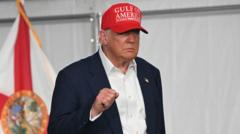In a notable shift in trade policy, President Trump unveiled a preliminary agreement with Vietnam aimed at rolling back existing tariffs on Vietnamese products, while tightening regulations on Chinese goods that may find their way through Vietnam into U.S. markets. This newly established trade pact highlights the durable nature of U.S. import dynamics amidst ongoing global supply chain changes.
Trump's New Trade Pact with Vietnam Signals Shift in U.S. Tariff Strategy

Trump's New Trade Pact with Vietnam Signals Shift in U.S. Tariff Strategy
President Trump announces a preliminary deal with Vietnam to recalibrate tariffs, opening up trade opportunities and indirectly targeting Chinese imports.
On July 2, 2025, President Trump declared on Truth Social that the United States has struck a trade deal with Vietnam, which entails reducing some punitive tariffs imposed earlier by the Trump administration for the purpose of fostering trade relations and enhancing market access for American products in Vietnam. The agreement is anticipated to indirectly influence the United States’ trading relationship with China, marking Vietnam as a strategic ally against alternative supply routes exploited by Chinese manufacturers.
Under the terms of the deal, a 20 percent tariff will be enforced on all imports from Vietnam, and a steeper 40 percent tariff will be levied on goods involved in "transshipping." This crucial provision was designed to combat concerns regarding the circumvention of U.S. tariffs by Vietnamese channels utilized by Chinese manufacturers. While the specifics of which goods will qualify for this higher tariff remain elusive, it is believed that items shipped from Vietnam may either originate from China or contain substantial Chinese components.
Commerce Secretary Howard Lutnick further clarified this stipulation via a post on X, indicating that imports featuring content from other countries processed through Vietnam would incur the additional 40 percent tariff. This stance encapsulates the U.S. administration's commitment to ensuring fair trade practices while addressing the complexities inherent in global trading networks.
As trade scenarios continue to evolve, this preliminary pact with Vietnam not only reflects a tactical pivot for U.S.-Vietnam relations but also serves as a broader commentary on American trade policy in an increasingly interconnected economic climate.
Under the terms of the deal, a 20 percent tariff will be enforced on all imports from Vietnam, and a steeper 40 percent tariff will be levied on goods involved in "transshipping." This crucial provision was designed to combat concerns regarding the circumvention of U.S. tariffs by Vietnamese channels utilized by Chinese manufacturers. While the specifics of which goods will qualify for this higher tariff remain elusive, it is believed that items shipped from Vietnam may either originate from China or contain substantial Chinese components.
Commerce Secretary Howard Lutnick further clarified this stipulation via a post on X, indicating that imports featuring content from other countries processed through Vietnam would incur the additional 40 percent tariff. This stance encapsulates the U.S. administration's commitment to ensuring fair trade practices while addressing the complexities inherent in global trading networks.
As trade scenarios continue to evolve, this preliminary pact with Vietnam not only reflects a tactical pivot for U.S.-Vietnam relations but also serves as a broader commentary on American trade policy in an increasingly interconnected economic climate.




















